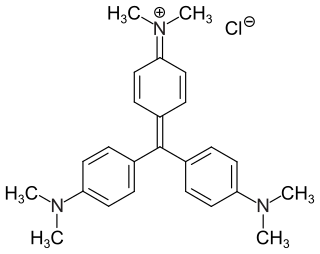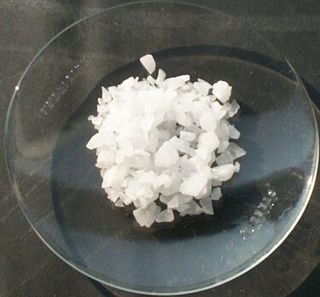Methyl violet is a family of organic compounds that are mainly used as dyes. Depending on the number of attached methyl groups, the color of the dye can be altered. Its main use is as a purple dye for textiles and to give deep violet colors in paint and ink. It is also used as a hydration indicator for silica gel. Methyl violet 10B is also known as crystal violet and has medical uses.
Methanogens are anaerobic archaea that produce methane as a byproduct of their energy metabolism, i.e., catabolism. Methane production, or methanogenesis, is the only biochemical pathway for ATP generation in methanogens. All known methanogens belong exclusively to the domain Archaea, although some bacteria, plants, and animal cells are also known to produce methane. However, the biochemical pathway for methane production in these organisms differs from that in methanogens and does not contribute to ATP formation. Methanogens belong to various phyla within the domain Archaea. Previous studies placed all known methanogens into the superphylum Euryarchaeota. However, recent phylogenomic data have led to their reclassification into several different phyla. Methanogens are common in various anoxic environments, such as marine and freshwater sediments, wetlands, the digestive tracts of animals, wastewater treatment plants, rice paddy soil, and landfills. While some methanogens are extremophiles, such as Methanopyrus kandleri, which grows between 84 and 110°C, or Methanonatronarchaeum thermophilum, which grows at a pH range of 8.2 to 10.2 and a Na+ concentration of 3 to 4.8 M, most of the isolates are mesophilic and grow around neutral pH.

Crystal violet or gentian violet, also known as methyl violet 10B or hexamethyl pararosaniline chloride, is a triarylmethane dye used as a histological stain and in Gram's method of classifying bacteria. Crystal violet has antibacterial, antifungal, and anthelmintic (vermicide) properties and was formerly important as a topical antiseptic. The medical use of the dye has been largely superseded by more modern drugs, although it is still listed by the World Health Organization.

Aluminium sulfate is a salt with the formula Al2(SO4)3. It is soluble in water and is mainly used as a coagulating agent in the purification of drinking water and wastewater treatment plants, and also in paper manufacturing.

Mycoremediation is a form of bioremediation in which fungi-based remediation methods are used to decontaminate the environment. Fungi have been proven to be a cheap, effective and environmentally sound way for removing a wide array of contaminants from damaged environments or wastewater. These contaminants include heavy metals, organic pollutants, textile dyes, leather tanning chemicals and wastewater, petroleum fuels, polycyclic aromatic hydrocarbons, pharmaceuticals and personal care products, pesticides and herbicides in land, fresh water, and marine environments.
Daeguia is a genus in the phylum Pseudomonadota (Bacteria).
Comamonas granuli is a Gram-negative, catalase-positive, oxidase-positive, non-spore-forming, motile, rod-shaped bacterium from the genus Comamonas and family Comamonadaceae, which was isolated from microbial granules.
Hydrogenophaga atypica is a Gram-negative, oxidase-positive, rod-shaped, motile bacterium from the Comamonadaceae family, which was isolated from wastewater from an activated sludge. The colonies of H. atypica are pale yellow.
Hydrogenophaga caeni is a Gram-negative, anaerobic, catalase- and oxidase-positive, motile bacterium from the Comamonadaceae family, with a single polar flagellum, which was isolated from an activated sludge. Colonies of H. caeni are white colored.
Hydrogenophaga defluvii is a Gram-negative, oxidase-positive, rod-shaped, motile bacterium from the Comamonadaceae family, which was isolated from wastewater. Colonies of H. defluvii are pale yellow in color.
Pigmentiphaga daeguensis is a gram-negative, non-spore-forming, rod-shaped, non-motile bacterium from the genus Pigmentiphaga, which was isolated from wastewater of a dye works in Daegu in South Korea
Shewanella decolorationis is a gram-negative, dye-decolorizing bacterium first isolated from activated sludge of a waste-water treatment plant. It is motile by means of a single polar flagellum. The type strain is S12T. Its genome has been sequenced.
Chelatococcus daeguensis is a Gram-negative, non-spore-forming bacteria from the genus of Chelatococcus which was isolated from wastewater of a textile dye works in Daegu in the Republic of Korea.
Daeguia caeni is a Gram-negative, non-spore-forming bacterium from the genus Daeguia, which was isolated from sludge of a textile dye works in Daegu in Korea.
Chryseobacterium daeguense is a Gram-negative and rod-shaped bacteria from the genus Chryseobacterium which has been isolated from wastewater from a textile dye works in Daegu in Korea.
Acinetobacter pakistanensis is a Gram-negative, strictly aerobic, psychrotolerant, heavy metal-tolerant and non-motile bacterium from the genus Acinetobacter which has been isolated from a textile dyeing wastewater treatment pond in Islamabad in Pakistan.
Xenophilus azovorans is a bacterium from the genus Xenophilus which has been isolated from soil in Switzerland.
Mucilaginibacter defluvii is a Gram-negative, rod-shaped, aerobic and non-motile bacterium from the genus of Mucilaginibacter which has been isolated from a dye wastewater treatment facility in Korea.
Hydrogenophaga crassostreae is a Gram-negative, rod-shaped, aerobic and motile bacterium from the genus of Hydrogenophaga which has been isolated from the oyster Crassostrea gigas.
Hydrogenophaga soli is a Gram-negative, rod-shaped, strictly aerobic and motile bacterium from the genus of Hydrogenophaga which has been isolated from soil from a rice field from Goyang in Korea.


